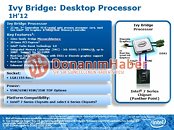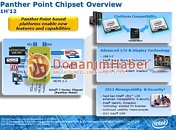- Joined
- Oct 9, 2007
- Messages
- 47,657 (7.43/day)
- Location
- Dublin, Ireland
| System Name | RBMK-1000 |
|---|---|
| Processor | AMD Ryzen 7 5700G |
| Motherboard | Gigabyte B550 AORUS Elite V2 |
| Cooling | DeepCool Gammax L240 V2 |
| Memory | 2x 16GB DDR4-3200 |
| Video Card(s) | Galax RTX 4070 Ti EX |
| Storage | Samsung 990 1TB |
| Display(s) | BenQ 1440p 60 Hz 27-inch |
| Case | Corsair Carbide 100R |
| Audio Device(s) | ASUS SupremeFX S1220A |
| Power Supply | Cooler Master MWE Gold 650W |
| Mouse | ASUS ROG Strix Impact |
| Keyboard | Gamdias Hermes E2 |
| Software | Windows 11 Pro |
Some time in the first half of 2012, Intel will release its next generation of desktop processors for the LGA1155 socket, based on the new Ivy Bridge silicon. Ivy Bridge is a 22 nanometer die-shrink of Sandy Bridge, with a few features added/improved. Ivy Bridge's smaller die size will allow for increased clock speeds and reduced production costs. A presentation was leaked to the press, which reveals quite a bit about the new chips. To begin with, Ivy Bridge processors are seamlessly compatible with existing LGA1155 platforms, and "Cougar Point" P67, H67, H61, Z68, chipsets, although it will come with its own 7-series chipset.
For the most part, Ivy Bridge is identical to Sandy Bridge, being an optical shrink from existing 32 nm to 22 nm. It will feature a new dual-channel DDR3 memory controller with official support for DRAM speeds of up to DDR3-1600 MHz. There's the usual PCI-Express 2.0 x16 hub that can drive up to two discrete graphics cards with electrical x8 connections. The integrated graphics controller will face an overhaul, it will be DirectX 11 compliant. It will also support the next version of Intel QuickSync GPU-accelerated video encoding technology. Turbo Boost 2.0 will be carried forward. TDP ranges in the usual 95/65/45/35W options.


Moving on, the next slide shows how Sandy Bridge, Ivy Bridge processors; and Cougar Point, Panther Point chipsets are seamlessly compatible with each other. Ivy Bridge processors can run on existing 6-series chipsets, Sandy Bridge should be able to run on Panther Point 7-series chipsets as well. The incentive in Panther Point chipset, however, is that it will feature a newer FDI interface that will support up to three displays running simultaneously; and that it will feature an integrated USB 3.0 controller. USB 3.0 will be implemented in a similar fashion as SATA 6 Gb/s on Cougar point, only some, not all USB ports will be SuperSpeed ports.

View at TechPowerUp Main Site
For the most part, Ivy Bridge is identical to Sandy Bridge, being an optical shrink from existing 32 nm to 22 nm. It will feature a new dual-channel DDR3 memory controller with official support for DRAM speeds of up to DDR3-1600 MHz. There's the usual PCI-Express 2.0 x16 hub that can drive up to two discrete graphics cards with electrical x8 connections. The integrated graphics controller will face an overhaul, it will be DirectX 11 compliant. It will also support the next version of Intel QuickSync GPU-accelerated video encoding technology. Turbo Boost 2.0 will be carried forward. TDP ranges in the usual 95/65/45/35W options.


Moving on, the next slide shows how Sandy Bridge, Ivy Bridge processors; and Cougar Point, Panther Point chipsets are seamlessly compatible with each other. Ivy Bridge processors can run on existing 6-series chipsets, Sandy Bridge should be able to run on Panther Point 7-series chipsets as well. The incentive in Panther Point chipset, however, is that it will feature a newer FDI interface that will support up to three displays running simultaneously; and that it will feature an integrated USB 3.0 controller. USB 3.0 will be implemented in a similar fashion as SATA 6 Gb/s on Cougar point, only some, not all USB ports will be SuperSpeed ports.

View at TechPowerUp Main Site


 now thats a first...
now thats a first...




 i forgot about clarkdale..
i forgot about clarkdale..